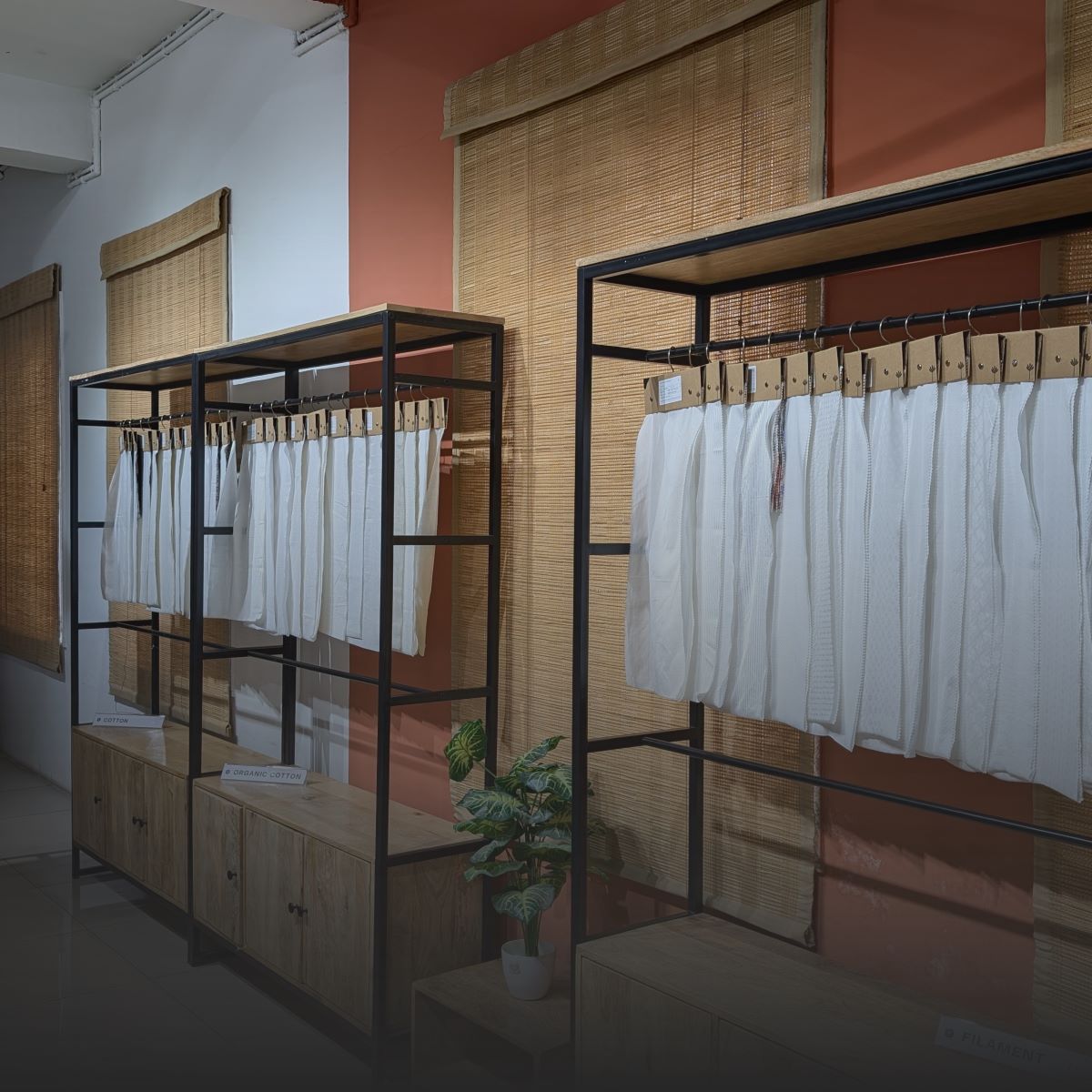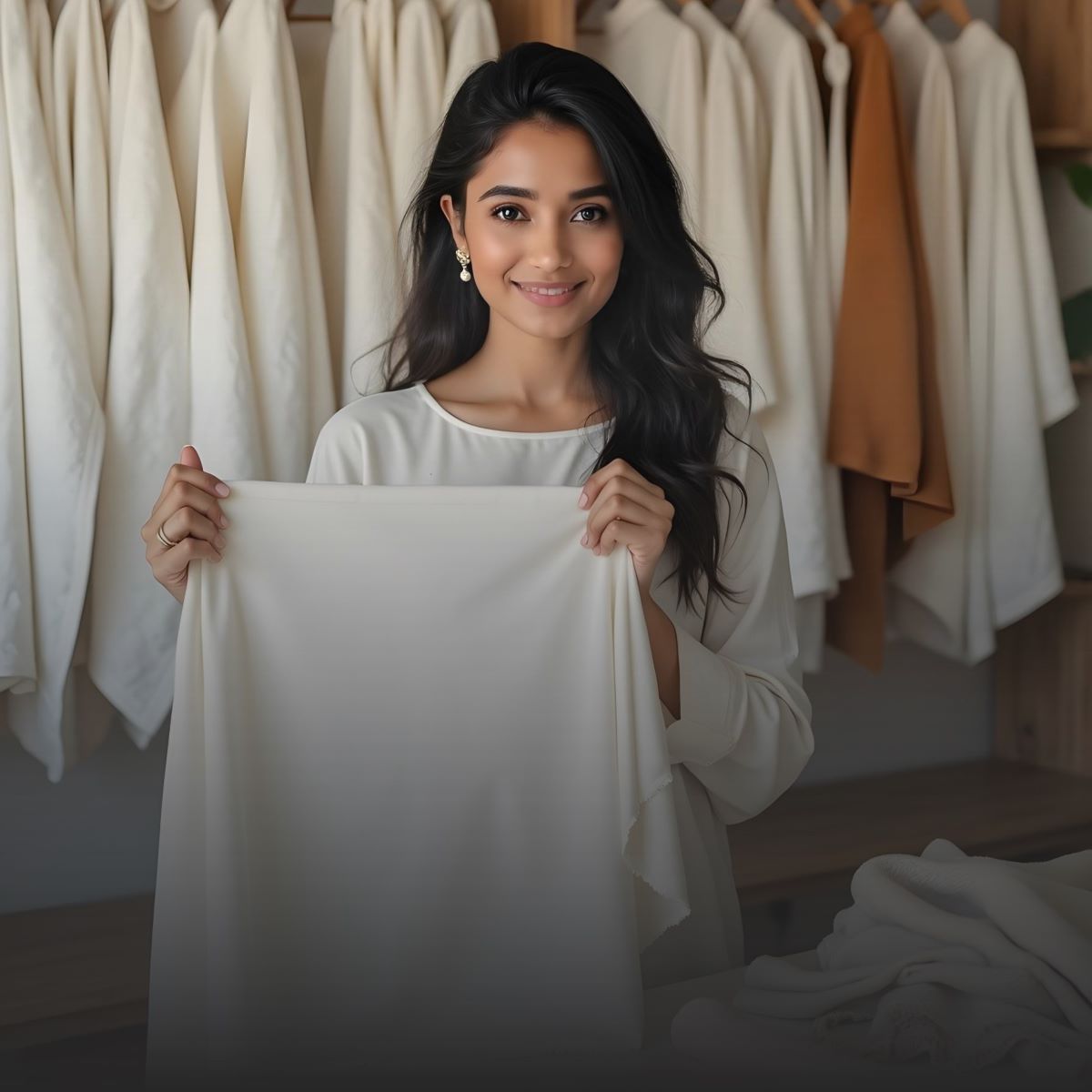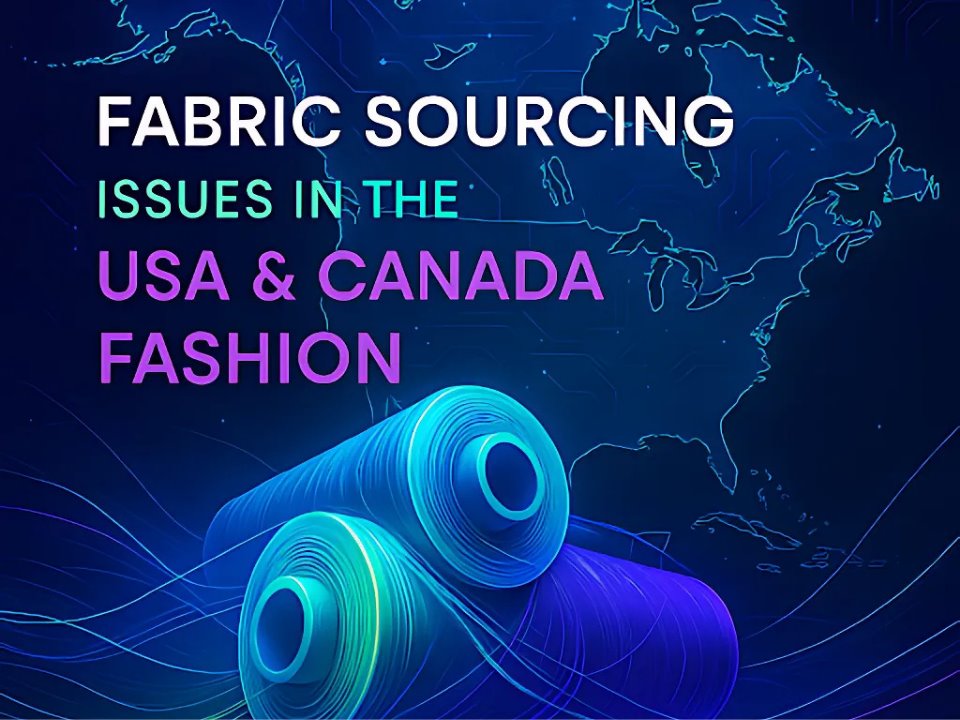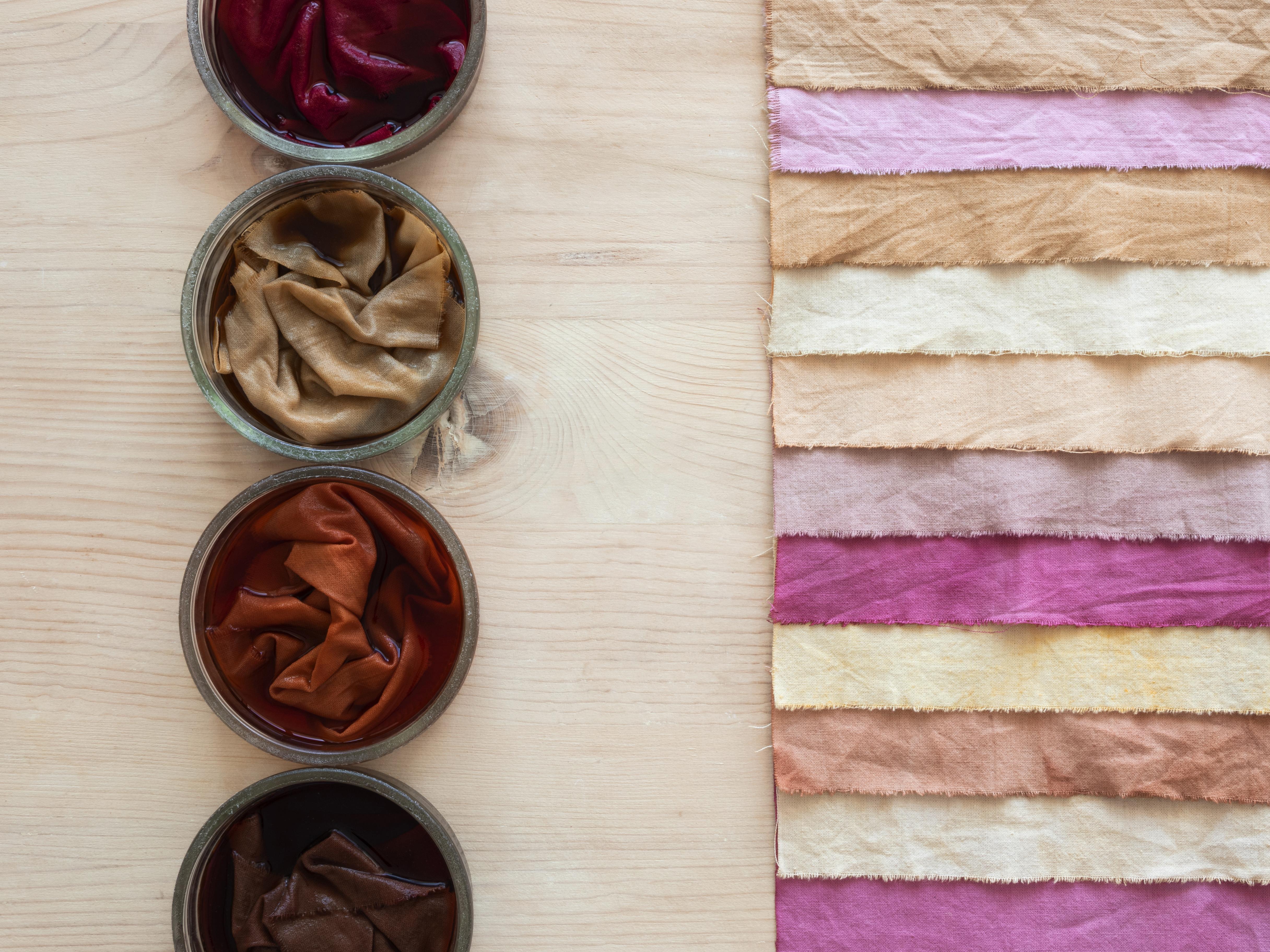Introduction to Fabric Sourcing
What is fabric sourcing?
Fabric sourcing means finding and buying the right fabric for your clothing. It is the first step in making any garment. The fabric you choose affects how your product looks, feels and lasts. Without good fabric sourcing, your designs cannot reach their full potential.
Why does it matter for fashion businesses in the USA and Canada?
In the USA and Canada, many fashion businesses find it hard to get the fabrics they need. Local markets have fewer choices and higher prices. This limits your design options and makes production more expensive. Getting the right fabric at the right price is important to stay competitive and make a profit.
Who faces these sourcing problems?
Small brands, startups and even established businesses face fabric sourcing issues. High minimum orders stop small buyers. Large companies face delays and quality issues. These problems slow production and increase costs.
What this blog will help solve
This blog explains common fabric sourcing problems in the USA and Canada. It shows how you can solve these issues. You will get clear steps to improve sourcing, save money and get better quality fabric.
How Fabriclore fits into the solution
Fabriclore is a fabric supplier that serves buyers in the USA and Canada. It offers many fabric types with low minimum orders. Fabriclore delivers good quality fabric on time. It supports customization and provides clear pricing. Using Fabriclore can simplify your fabric sourcing.
Also Read: How to Source Fashion Fabric for Your Clothing Business in the USA
Fabric Sourcing Challenges and Solutions for Fashion Businesses in the USA & Canada
Sourcing fabric for fashion businesses in the USA and Canada can be challenging. Common issues include fewer local fabric options, high minimum order requirements, delays in delivery, extra hidden costs and uneven fabric quality. This guide explains these problems and offers simple solutions, such as better planning and choosing the right global supplier.
Also Read: Top Fabric Sourcing Destinations in Canada: A Designer’s Guide
These are the common challenges faced by fashion businesses in the USA and Canada.
- Limited Local Fabric Choices in the USA and Canada
- High Minimum Order Quantities (MOQs)
- Quality Inconsistency and Material Defects
- Delays and Long Lead Times
- Sourcing from Multiple Suppliers
- Lack of Customization and Print Flexibility
- Complex Import Duties and Pricing Transparency
- Difficulty Understanding Fabric Specs
1. Limited Local Fabric Choices in the USA and Canada

Local fabric markets in the USA and Canada often do not have all the fabric types needed for different fashion and product designs. This limits your design options, makes planning harder and can delay production. Using global sourcing platforms with a wide range of fabrics can help fix this problem.
Why Local Suppliers in the USA and Canada Do Not Meet the Full Spectrum of Fabric Needs
- Many local stores focus on standard fabrics only.
- They stock limited types, colors and patterns.
- Specialty fabrics like Bemberg, organic cotton or Tencel are hard to find.
- Import restrictions and low demand reduce variety.
- Bulk orders for niche fabrics are not always possible.
Result: You face design blocks and longer wait times.
Impact on Design Freedom and Material Planning
- You cannot explore new styles due to limited fabric access.
- Planning becomes harder with fewer fabric choices.
- You spend more time sourcing than designing.
- Unavailable fabrics delay product launches.
- Your creativity and business both slow down.
Ask yourself: Are you choosing designs based on availability, not creativity?
What to Look For When Variety Is Limited
You need to plan smarter. Look for:
- Suppliers who offer fabric swatches online.
- Low minimum order quantities.
- Access to sustainable, premium and seasonal fabrics.
- Lead times that fit your schedule.
- Custom prints or dyeing options.
Avoid relying on one store. Explore beyond your region.
How Global Sourcing Platforms Like Fabriclore Solve This
Fabriclore helps you bypass local limits. You get:
- Thousands of fabric options in one place
- Access to organic, sustainable and designer-grade fabrics
- Fast delivery to the USA and Canada
- Dedicated support for designers and small businesses
With Fabriclore, you choose your fabric first, not your limitations.
2. High Minimum Order Quantities (MOQs)

Minimum Order Quantity (MOQ) is the smallest fabric amount a supplier sells. High MOQs limit small businesses by forcing large purchases.
What is MOQ and Why Does It Limit Small Businesses?
- MOQ means you must buy a fixed minimum amount of fabric.
- Small businesses often need less fabric but cannot order less than MOQ.
- This blocks you from buying exactly what you need.
- You pay more upfront and risk excess stock.
How High MOQs Impact Cost and Inventory
- Large orders increase initial spending.
- You store more fabric than needed.
- Excess stock can remain unused or become obsolete.
- Managing big inventory adds cost and complexity.
High MOQs reduce your financial flexibility and slow down product testing.
What Does Low MOQ Sourcing Look Like?
- You pay less upfront and reduce storage needs.
- You can try new fabrics and designs quickly.
- This approach fits small brands and startups better.
How Fabriclore Supports Low MOQ Buyers Globally
- You can buy quality fabrics without large commitments.
- Fabriclore provides fabric samples to check before ordering.
- Custom prints and diverse fabric types are available at low MOQs.
- This helps small businesses buy smart and grow sustainably.
Ordering fabric with low MOQs reduces risk and cost. Fabriclore’s flexible options make fabric buying easier for small brands worldwide.
3. Quality Inconsistency and Material Defects

Inconsistent fabric quality is one of the biggest risks in fashion manufacturing. A slight variation in weave, finish or dye can disrupt your entire production cycle.
What Happens When Fabric Quality Varies
When fabric batches differ in texture, weight or color, it affects everything from stitching to the final look. Even a small defect can make garments unsellable—costing both time and money.
How It Affects Fit, Finish and Customer Returns
- Inconsistent quality directly impacts the fit and drape of a garment.
- The stitching may pull or seams may not align.
- This often leads to high rejection rates during quality checks—and worse, increased customer returns and negative reviews.
How to Evaluate Fabric Before Bulk Purchase
- Always request swatches or sample yardage before placing a bulk order.
- Check for colorfastness, shrinkage, stretch recovery and hand feel.
- Conduct small production tests to ensure the fabric behaves well during stitching, washing and ironing.
- Prefer suppliers who offer transparent composition and technical specs.
How Fabriclore Ensures Quality Through Pre-checks, Swatches and Testing
- Every order goes through strict quality checks, inspecting fabrics for over 20 types of defects. Fabriclore also tests shrinkage and color fastness to ensure consistency. For extra confidence, brands can ask for custom lab testing.
- You can order swatches before committing to a bulk purchase, helping you assess texture, color and finish in advance.
With Fabriclore, you get fabric that’s consistent, reliable and ready for production—no surprises, no costly rework.
4. Delays and Long Lead Times

In fashion, time is everything. A delay in fabric delivery can stall production, push back launch dates and derail marketing plans.
Why Delayed Deliveries Hurt Production Timelines
When fabrics don’t arrive on time, sampling gets delayed, stitching schedules are missed and entire production cycles are pushed back.
For small businesses and independent designers, even a week's delay can mean missing seasonal opportunities or losing out to faster competitors.
How to Prevent Missed Launch Windows
To stay on schedule, it’s critical to plan ahead and work with suppliers who commit to realistic timelines.
Always confirm:
- Estimated delivery time before placing orders
- Whether the fabric is made-to-order or ready-to-ship
- If the supplier offers tracking and real-time updates
Strong communication with the supplier at every step can prevent last-minute surprises.
The Importance of Supplier Coordination and Visibility
Having visibility into sourcing, dispatch and delivery timelines helps brands optimize planning and maintain agility.
A transparent supply chain means you can update your internal teams or clients proactively—rather than reacting to issues too late.
Fabriclore’s Trackable Logistics and Time-Bound Delivery Promise
Fabriclore addresses this challenge with a trackable logistics system and committed delivery timelines, whether you are buying ready-to-ship stock or placing a custom order.
Their team provides real-time updates on order processing and dispatch, so you can plan your production flow with confidence.
For international buyers, Fabriclore works with reliable shipping partners to ensure timely delivery across the globe.
Fabriclore’s dependable timelines help you stay on track, so your launches hit the market exactly when they should.
5. Sourcing from Multiple Suppliers

Managing multiple vendors may seem flexible, but it often leads to confusion, inconsistency and delays—especially for small brands juggling tight timelines.
What Risks Arise When Dealing with Too Many Vendors
When fabric comes from different sources, there’s a higher risk of mismatched dye lots, variable quality and inconsistent timelines.
Each vendor has different policies, processes and communication styles—making it hard to track everything and stay aligned across your production stages.
Impact on Consistency and Communication
Juggling many suppliers means more coordination, more follow-ups and greater chances of miscommunication.
If even one supplier misses a deadline or changes a spec, it can hold up your entire project or compromise the final product’s uniformity.
How to Simplify Sourcing Through One Channel
The easiest way to reduce complexity is to partner with a supplier that offers:
- A diverse fabric portfolio
- Reliable delivery and customization services
- Support for both low and bulk MOQs
This lets you focus on product development—not supplier coordination.
How Fabriclore Offers All Key Fabric Types Under One Roof
Whether you're prototyping or placing large-scale orders, you’ll find everything in one place.
Plus, their expert team assists in selection, swatch testing and customization—making sourcing efficient, centralized and brand-ready.
6. Lack of Customization and Print Flexibility

In today’s design-driven market, originality is everything. For private labels and D2C brands, fabric customization isn’t a luxury—it’s a necessity.
Why Customization Matters for Private Labels and D2C Brands
Your brand identity often begins with the fabric—whether it’s a unique color palette, exclusive prints or specific textures.
Without customization options, you risk blending into a saturated market or compromising your creative vision.
What Limits Creative Freedom When Sourcing Fabrics
Traditional wholesale suppliers often demand high MOQs for customizations or limit print options to existing catalogs.
This blocks experimentation and delays product development, especially for smaller brands or early-stage collections.
How to Find Suppliers Who Offer Dyeing, Printing and Design Support
Look for fabric partners who:
- Offer low-MOQ customization
- Provide multiple printing techniques (like digital printing, block printing or screen printing)
- Support mockups and pre-production sampling
Such flexibility ensures your designs are not only feasible but also scalable.
What Fabriclore Offers: Custom Prints, Digital Mockups and Sampling Support
Fabriclore empowers designers with print-on-demand capabilities, design digitization and fabric dyeing across a wide base of materials.
From sampling support to digital mockups, their team helps turn concepts into ready-for-production textiles—without forcing high-volume commitments.
You also get to work closely with design experts who ensure every color, motif and texture aligns with your brand’s look and feel.
Fabriclore helps transform your creative ideas into unique fabrics—made to stand out, made to sell.
7. Complex Import Duties and Pricing Transparency

For many North American businesses, the landed cost of fabric often turns out far higher than expected—thanks to hidden fees, variable duties and opaque quotes.
What Drives Up Fabric Costs in North America
The base price of fabric is just the beginning. Add freight charges, import duties, taxes and surprise handling fees and your sourcing budget can spiral fast—especially when sourcing internationally.
How Shipping, Taxes and Hidden Fees Hurt Profit Margins
Inconsistent invoicing or post-purchase charges reduce clarity and erode profitability. This unpredictability makes it hard for small brands to forecast production costs or price their products accurately.
How to Find Price Clarity and Save on Cost
Reliable suppliers offer:
- Upfront, all-inclusive pricing
- Global shipping knowledge
- Guidance on import regulations
Such transparency helps brands plan better, avoid customs delays and improve cash flow.
Fabriclore’s Global Pricing, Tax-Inclusive Quotes and Export Experience
Fabriclore simplifies global fabric sourcing by providing clear, tax-inclusive pricing and export-ready documentation.
With years of experience shipping globally—including to the US, UK, Canada and Australia—they handle customs compliance, export paperwork and optimize logistics to ensure you receive what you paid for, on time.
8. Difficulty Understanding Fabric Specs

Selecting the wrong fabric can derail an entire collection—leading to fitting issues, production waste or returns. Many of these mistakes stem from unclear or misread fabric specifications.
Why Businesses Pick Wrong Fabrics for Wrong Use
Without technical knowledge, it’s easy to confuse blends, misjudge GSM or pick a fabric with poor drape or stretch for the intended design—resulting in performance issues and dissatisfied customers.
Common Mistakes in Spec Sheets and GSM Misreading
Even trained teams sometimes overlook shrinkage percentages, weave types or surface finishes. Misreading GSM can lead to fabrics that are too thin, too heavy or simply not suited for the end product.
How to Train Your Team and Ask the Right Questions
Educate your sourcing and design teams to:
- Interpret GSM, weave and fiber content accurately
- Ask for performance characteristics (shrinkage, pilling, breathability)
- Request swatches or lab dips before committing to large orders
How Fabriclore Educates Buyers with Fabric Data and Usage Guides
Fabriclore bridges the knowledge gap by providing detailed spec sheets, GSM data and design-use recommendations for every fabric.
Fabriclore’s expert support team also helps new buyers select the right fabric based on garment type, climate or end-user expectations—ensuring your choices match your vision and function.
Practical Checklist: How to Source Smarter
Smart sourcing isn’t just about finding the lowest price—it’s about consistency, quality and scalability. Here’s how your team can make informed decisions.
What Steps Should Sourcing Teams Take Today
- Audit current suppliers for delivery timelines, MOQ flexibility and fabric consistency
- Identify where communication gaps or unexpected costs are impacting production
- Build a shortlist of transparent, reliable partners with global supply readiness
Questions to Ask Suppliers Before Ordering
- Can you share fabric specs, GSM and composition details up front?
- What is your MOQ for bulk and custom orders?
- Do you provide swatches or digital previews before production?
- Are prices inclusive of taxes, duties and freight?
Tools to Use for Quality and Cost Control
Use tools like:
- Fabric comparison charts
- Digital mockups
- Order tracking dashboards
- Sampling and pre-production swatches to reduce errors
How to Trial Fabriclore’s Platform with Swatches or Bulk Orders

Fabriclore makes it easy to start small. You can:
- Order sample swatches or custom prints with low MOQs
- Test logistics, delivery timelines and quality firsthand
- Scale confidently after validating product performance
Also Read: What are the Key Differences Between USA and Canadian Fabric Markets?
Conclusion
Sourcing the right fabric is crucial for any fashion business, especially in today’s fast-moving market. Challenges like high minimum orders, inconsistent quality, long delivery times, hidden costs and limited customization can slow down production, increase costs and limit creativity. But with the right partner, these problems can be solved.
Fabriclore offers a simple and reliable sourcing solution for fashion brands in the USA, Canada and beyond. With low minimum orders, easy sampling, clear pricing and a wide range of fabrics all in one place, Fabriclore makes sourcing easier and more cost-effective. Whether you are starting out or growing your business, Fabriclore helps you stay flexible, creative and efficient. Ready to improve your fabric sourcing? Start with Fabriclore’s custom fabric support today.
Also Read: Top Fabric Sourcing Hubs in the USA: A Designer’s Guide
FAQs
What is the sourcing process of fabric?
Fabric sourcing involves identifying, evaluating and procuring the right textile materials that match your design, quality and production needs. It includes researching suppliers, requesting swatches, reviewing specs like GSM and weave, negotiating MOQs and pricing and ensuring timely delivery. Platforms like Fabriclore simplify this process with pre-tested listings, customization options and global shipping.
What are the different types of sourcing in the apparel industry?
Apparel brands use several sourcing models—direct sourcing from manufacturers, agent-based sourcing and platform-based sourcing like Fabriclore. Some work with multiple small suppliers for variety, while others rely on consolidated vendors for consistency. Low MOQ platforms and export-ready suppliers now allow hybrid models tailored to brand size and geography.
What role does fabric sourcing play in the quality of garments?
Fabric quality directly impacts the look, fit, durability and customer satisfaction of a garment. Poorly sourced fabric can lead to shrinkage, color bleeding or returns. Good sourcing ensures consistent specs, proper testing and smooth production. Fabriclore supports quality control with in-house defect checks, swatches and optional lab testing.
How to become a fabric sourcer?
Start by learning textile types, weaving methods and key specs like GSM, drape and blends. Gain experience by working with suppliers, visiting mills and understanding production timelines. Tools like Fabriclore’s digital catalog, usage guides and sourcing support can train you to evaluate fabrics confidently and source like a pro.
Looking for trusted wholesale fabric suppliers in the USA or a reliable wholesale fabric supplier in Canada? Explore top-quality textiles at unbeatable prices—your one-stop sourcing destination!
We also happen to be a magnet for suggestions, and would love to catch yours….throw us yours on hello@fabriclore.com




